SYLLABLE SONG IN WATER AND STONE
--for
Mayumi Kaneko
This is the suiseki workshop.
Before we go out on the river we gather around our sensei for protocols. Those of you who are married, will want to
take off your rings. You might scratch the stones. Suiseki is the Japanese
Art of Miniature Landscape Stones. Kawa Dojo is the classroom on the river.
Increased longing for rocks and
trees in the gardens speaks to me of many sanctuaries. I felt entrances and
exits, but I had no way to assist guests in knowing how to enter each one. I
would need something like a gate with no fence. I didn't yet know how to simply
call it No Gate. A friend helped me construct the Gate With No Fence from yucca
canes after their flowering. Gate-With-No-Fence became its name. They would
become many, and friends were granted sanctuary with a single step.
After the birch trees developed,
I began pruning birch limbs with their white papyrus-like bark for the No-Gates
which could be placed anywhere in the gardens. I would tie the limbs with
twine, or sometimes with a beautiful lightweight copper wire. The
Gates-With-No-Fences kept nothing out, emptying wondrously and never-filling.
*
The Bashō scroll came in the
mail.
Thirty years ago, when our
daughters were in high school, our family hosted two Japanese exchange students
from Yamate High School in Yokahama, Japan. The following year, our daughters
visited the two girls who stayed with us on a personal exchange, and staying in
their homes. The girls, now in their mid-40s, have stayed in touch, especially
with the development of social media.
Twenty five years ago is about
the time that my study of Bashō, with the publication of Sam Hamill's
translation of Bashō's Narrow Road to the Interior, began to take a more
serious place in my life. Hamill's Bashō came into my hands in Yakima,
Washington where I lived, taught, and published poetry from Blue Begonia Press
with my wife Karen.
One day this winter, as I was
studying haiku through the Upaya Zen Center in New Mexico, Mayumi Kaneko, sends
me a text saying, "I have been to see Bashō!" A startling
synchronicity, yes; another startling stop along the Star River that was still
opening.
Mayumi had just returned from
Yamadera in the prefecture of Yamagata, where she had walked where Bashō
walked. Where she had read his famous Haiku:
In the utter silence
Of a temple,
A cicada's voice alone
Penetrates the rocks
Spilling over in joy at her
experience, Mayumi let me know that there would be more to come. I had no way
of knowing about her treasure gifts that would come in the mail. She did send a
saying, Ichigo Ichie from the tea ceremony, Treasure
every encounter. Treasure every meeting, for it will never recur.
It so happens, as it so often
does in the world of poetry, that I had been in the prefecture of Yamagata, but
did not know of Bashō other than the haiku of the pond and the frog. For
decades I would not begin to contemplate the pond. I went to Viet Nam in the
summer of 1967, a buck sergeant at the 85th Evacuation Hospital in Qui Nhon,
Bin Dinh Province. In January, 1968, I took an R&R (Rest and Relaxation)
and went skiing in Japan. Myself and one other enlisted man took the train
north to Zao where we skied for four days. We returned on the 29th or 30th of
January, as the Tet offensive was under way and we couldn't get out of Tan Sanh
Nhut Air Base to get back to the 85th Evac Hospital for several days. Our lives
changed when we skied Mt. Zao and bathed in the hot springs. They changed again
during the Tet Offensive.
***
Nobuki Yuasa's translation of
Bashō's The Narrow Road to The Deep North, is now my preferred text, and I did
not realize that I was an hour away from Basho's temple stop at Yamadera. It
had taken me a quarter century to realize its importance.
Yuasa's translation reads: There
was a temple called Ryūshakuji in the province of Yamagata. Founded by the
great priest Jikaku, this temple was known for the absolute tranquility of its
holy compound.
What stillness!
The voices of the cicadas
Penetrate the rocks
Reginald Horace Blyth's
translation.
By now Mayumi is researching for
our family, sending translations to Karen:
Ah, tranquility!
Penetrating the very rock,
A cicada's voice
by Helen Craig McCullough
Mayumi tells me, Yamadera is a
temple. Yama is mountain, and Dera is temple.
***
Here is Sam Hamill's translation
of Bashō at Yamadera from Narrow Road to the Interior:
In Yamagata province, the ancient
temple founded by Jikaki Daishi in 860, Ryūshaku Temple is stone quiet,
perfectly tidy. Everyone told us to see it. It meant a few miles extra,
doubling back towards Obanazawa to find shelter.
Lonely stillness
A single cicada's cry
Sinking into stone
Hamill, friend, mentor,
translator, poet, publisher, iconoclast...
I came to Hamill's Bashō in
midlife, lost again. Dante's Inferno met me also. Personal guides for each
showed up almost simultaneously. Both crucial--and present during the ensuing
quarter of a century. Bashō, however became the daily companion, paperback in
the knapsack.
Home as road. Road as journey.
Hamill followed Bashō's path, but Hamill's was always an interior journey.
Sam Hamill and Nobuki Yuosa would
be my daily companions. A copy in the mothership. A copy in the knapsack.
***
What I come up with this time in
my notebook:
Quiet
cicada sings
into stone
and this:
Still
cicada sings
into stone
*
WHAT WOULD BASHŌ SAY
or Jesus.
I was 22, studying
literature, pre-conscious,
wearing a United States
Army uniform, buck sergeant
at the 85th Evacuation Hospital,
Qui Nhon, Vietnam,
21 January 1968, when
I flew to Mt. Zao
to ski on R&R
took the train North
to Yamagata prefecture
where Bashō wrote
cicadas penetrating stones
worshipping at Yamadera,
me an hour away,
man-child born
9 August 1945
skiing. soaked
in hot springs--
before returning
to Tan San Nhut
30 January 1968,
country in flames,
that close,
I am that close.
Jim Bodeen
11 March 2019
*
Storypath/Cuentocamino
Every day I write the word
in my notebook, not knowing
how it brought me
to the butterscotch chair
*
Conversation as an adventure
Reading Whitman this winter with
two friends, the poet/watercolorist says, Those of us who came of age in 1968
in America unable to participate in normal American society.
Born in 1945, I've found people
born two years after me, inherited a different country than I did. Their
reality has been different. Their way of experiencing 1968, also? It's
interesting to consider that. One could still find out some things about this,
with the right tools.
Another thought. What does it
mean to devote one's life to poetry--especially in the context of Basho--this
thought came into my head skiing with my granddaughters in the Cascades. Bashō was
what, 49, when he wrote that he had given his life to poetry? What does it mean
to do this at the end of the second decade of the 21st Century? Giving all to
poetry without being ambition in the pursuit, not pursuit, in being present.
That. More than that to anyone. That's my question.
*
Tears in real time.
*
Not to listen to
But to become listener
Tears in real time
*
After crossing the river
he wanted to see
how far he could get
from the other side.
He was in a hurry.
No doubt about that.
*
It's February, 2014. He's looking
back in old notebooks. He doesn't do this very often. He is mixing soil for
bonsai trees. Red rock, pumice. Akadama. In equal parts. Pumice has insulating properties.
It creates heat, moisture and air within the pot. Fine particles clog up your
pot. Spray your tree in pot until water emerges clear. You don't know how
you're going to tie your tree in the pot until you look at the roots. Roots in
the bonsai tree will be the youngest part of the tree.
Song of the Tree's Duende...
Roots in deep rock
Waiting, surfacing
for willing eyes
Deep song in old trees
also listen
waiting for one
to tender its roots
To follow a road is to follow
diversity, a flow of inter-locked voices, arguing, laughing. Sipping jars of
green tea. Those you love take away a part of you, the self you were then. We
say that to forget is to break faith with the dead. My address lay among the
almonds, forgotten. As you settle, there is comfort, and a kind of sadness.
Bashō again. Bashō and Yuasa.
Seeking a vision of eternity in things that are. If I wrote that then, when did
my Bashō studies begin? Caught between seasons and practiced passions, in and
out of the Gobi-Rattler Room with my dog, Sadie--Sister Sadie Sadie--I go out
into garden with green tea and dig in the compost, mixing it up. The day with
sensei in his studio, I fall asleep in my chair, bed and blossom triggering.
Walking with Bashō, morning moves into mid-day. All morning cutting chopsticks
from bamboo. Tucking tender tree roots into bonsai pot.
And what did Bashō do? Bashō left
for Edo. He left a poem behind. Separated, we shall be forever, my friends. No
other alternatives but to leave the work of a man who casts himself
away--weather-exposed skeleton, a preliminary journey. There was a stream and a woman was washing potatoes.
Bringing language
down,
barely audible
not running
from anything
pruning randomly
walking yard
getting to know
what's here
***
He wandered by himself into the
heart of the mountains of Yoshini. There is only flower and moon in the dream,
all else, a barbarous mind. He keeps a record of himself, hires a horse and
climbs the steep slope of Support-Yourself-On-A-Stick Pass, and falls saddle
and all. He sees a fawn born on Buddha's birthday and talks the pleasures of
the iris. His companion Kawai Sogado takes the pen name Sora. They learn to see
from behind inside a cave. I sit in my old chair reading travel books, drinking
coffee from Brazil.
He had decided
to keep going
He was afraid
he'd go
into the world
and renounce it.
His notebook
and his camera
would find people
where they would
find them
This is the tree where the heart
is nourished. Work so the tree won't have to find its way again when you're
done. That's the secret of Yamadora. Bonsai collected in the wild. It's the
first day of spring, for God's sake. Put the camera down and go sit on a rock
in your garden.
***
Bashō and the trigger to walk. Dostoevsky
looking for light, must go by the way of the dark. . The privileged place of
door and what it means to be flesh. Next week is the anniversary of Oscar
Romero's death. He is reading travel books. I marched with others in San
Salvador on the 25th anniversary of his martyrdom. And Bashō's Narrow Journey to the Far North.
Let's say the fear comes from the same time as the beginning of the trees.
Brought to him by trees in pots. Working on his little trees, making them look
old. Un'Taneh-Tokef, who by fire. Journey to the hyphenated name. The oldest
part of who I am: a 10-year old boy. The duende loves the rim of the wound.
Apprenticed to the master Bonsai gardener, and told to prepare a pot for the
collected treasure, my left hand freezes.
Exile's memory
Uncovering unseen worlds
Traveling in spring
*
This is. Este es.
Este es el camino pedregoza.
The rocky road.
Supple-minded imagination
of inoffensiveness
and Biblical rigidity.
White man in a bonsai pot
with little trees.
Jesus is the opposite of
pressure.
If you can wire with soft hands
you can wire anything.
Little trees will thank you.
I haven't found a word
for the way it is when we're
together.
Quakers were ok calling it a
meeting--
this face-off of intimacy.
Ball players, monks and sex
workers
united interior practice.
Lectio divina is the most
neglected way
and might have the most
potential.
The contents of Crazy Horse's
Medicine Bag
will be revealed in time.
We are all here giving up
expectations
having come for the divine
which tells us of our selfishness.
Good material does not have to be
expensive. Roots, trunks, branches. Rootage itself hits the ground in flair.
The worst thing is a big tree and nothing interesting. Look for low branches.
We want our trees to look old. The teacher says, think of the tree as bowing
forward. Everything can be said in six lines. Bashō saw this coming, linking
his long walk to famous pines.
Nobuyuki Yuasa's Narrow Road
comes out of Hiroshima 20 years
after the bomb. Bashō leaves
his broken house on the River
Sumda
in August, determined to fall
weather-exposed,
a sore-wind blowing through his
heart.
The rock and the tree. Suiseki
and Bonsai,
time and creation. The particular
rock and tree. Wabi Sabi
The separate histories. Histories
together.
First the rock, then the tree.
The tree
is a pine. The stone another
story.
***
Suiseki with interesting
histories are known as yuraiseki. Masterpieces whose owners can be traced back
in time to the poets and politicians. To the powerful. One in particular, Cloud
Over Fuji, is a Furuya Suiseki found in the mountains of Wakayama Prefecture in
Southern Japan, black to dark grey lime stone, dense and hard. It resembles Mt.
Fuji with is summit covered by a quartz cloud. 41/2 by 7 inches. Its pedigrees
and documentation. Start here. A fibrous paper desk screen framed in bamboo
with calligraphy by Tomioka Tessai, 1837-1924, titled Cloud-Cover Lifting off
Mt. Fuji. Paper screen signed by Tessai, also bears the seal of three other
writers. A small album accompanies the stone. Calligraphy and paintings with an
accompanying poem.
Furuya Suiseki. Family name
meaning Old Valley. More accurately, Worlds within worlds. Old Room. Romance of
Scholar's Stone. Bones of Earth.
Two Divinities Dancing by Tessai.
Now at Honolulu Museum of Art. Furuya Suiseki Assemblage, it can now be
glimpsed online. Tessai painted 20,000 paintings. 70 in one day. His most
famous after he was 80. He died at the age of 87. Now to the pine.
***
Sam Hamill died this last year,
in 2018, and we have a long history. During the week when he died, and remained
physically present to us, I was in Pittsburgh walking the streets of the Hill
District where August Wilson grew up. I was in his libraries, his schools. And
I was also on my way to Martins Ferry, Ohio, to participate in a James Wright
Poetry Festival. Walking. Driving back roads in a rental car. Between places,
at the main Carnegie Library, the librarian walked me to the stacks where
Wilson's plays and poems were located, along with the emerging criticism of his
work. She walked me by a window sill over looking Tyrannosaurus Rex below, in
the next building, suggesting I might sit there. Because of this slight detour
we were in the 811 Section where poetry was located. After finding
unknown-to-me treasures of Wilson, I returned to Hamill's books, flooded in
memory. From the window-sill I wrote a draft of the poem I would complete in an
inexpensive hotel room that night in Wheeling, West Virginia.
JUST OFF I-70 WEST
Way back, back by steps,
stepping off 40, away again
from the national road
the Pike and national way
past Cumberland towards
the American trail
and Nemacolin's path,
rivers and watersheds connect.
Sam Hamill is dead. Gone six days.
Take the Buffalo Church Road.
Language telling me hard coal is smokeless.
Bring me a couple of Indian ponies.
Dreams here surface on their own.
People buried on this hill
all live so close to one another.
Peonies surface after long winter between stones.
Two brothers pack a bale of top soil
and plants for their parent's grave.
This is Clayville. Henry Clay
spent a night here, they say.
William McGuffey's ours.
School district's named for him
on account of the McGuffey Reader.
An agreement's been reached and
a third party is present. We'll assemble
together. A woman sitting in shade
watching her husband mow stops me
and I ask my question. The man says,
You can see it from here,
but getting there's another story.
There is a better road, he tries again.
I don't want to get there too soon.
No, he says, Too much daylight.
The past as present is a reckoning.
May all your fences have gates.
Sam's been gone all of six days.
I don't think he's ever going to leave us,
me and this little stack of books
in the window sill, this side
of the dinosaur looking down on the people.
Jim Bodeen
20 April 2019
***
Hamill and his partner Tree
Swenson at Copper Canyon press gave me a world. Blue Begonia Press is one of
the grandchildren of their work, subject of a different essay. Four years ago,
deep into bonsai and suiseki, I had also returned to Sam Hamill's Bashō, what
Hamill calls the interior.
He [Bashō] learned from Ikkyū's friend, Ryukū, that each tea ceremony
is the only tea ceremony. Therefore each poem is the only poem. Each moment is
the only moment in which one can be fully aware.
Hamill's Bashō takes the student
into mono-no-aware, elegant sadness in awareness, beauty in temporal things,
like pleasure, like travel. Recall Elizabeth Bishop's statement, Travel is the
saddest pleasure. What comes up besides the loneliness for you? It is a
pedestrian prayer. Matsu Shima on Pine Island. Each day begins with time's
gift. The building of the day around time and the practice of time. My granddaughter,
Sammie, has a birthday. I made it to
seven, Grandpa.
I have coffee with a friend. We
talk about Bashō, swim trunks, bleeding Madras shirts, high school felons, Kurt
Vonnegut.
Simultaneously, I'm carrying Sid
Corman's translation with Kamaikie Susumo's Backroads to Far Towns, Bashō's
Travel Journals, [1986 & 2004, White Pine Press, Illustrations by Hide
Oshiro]. Sid Corman, evoking a context, wanting it badly, of Bashō: The poems are not isolated instances of
lyricism, but cries of their occasions, of someone intently passing through a
world, often arrested by the momentary nature of things within an 'unfathomable
order.'
Personal note, flashback. In
2005, while riding Peace Train from Mississippi to D.C., during Hurricane
Katrina aftermath, New Orleans still under water. New Orleans was to be
embarkation point, so I flew to Jackson, Mississippi and then took a bus to
Meridian, where I got on the train. After midnight a bearded man boarded in
Atlanta. He had flown from Korea to fly this train. He had a brief case full of
poems. My seat passenger. He was the caretaker of Sid Corman's journals.
Travel gets us moving. Here's
Corman again, from his Introduction: His
words are our provision, breath, rhythm. And they can never not be our time.
The end of his journey is the end of ours. Everywhere he goes one feels a
sounding made, the ground hallowed, hard on, endeared to him, and so to us,
through what others had made of he had reached, discovered...So many today who
have lost touch have lost touch with just such grounds for being.
I began this reading of Bashō
five years ago, on March 8. My notebook now reads June 24. I know this from the
inside of the Yuosa translation I hold in my hand. On March 8th I purchased two
books, Lorca's Little Book of Duende, and Yuousa's Narrow Journey to the Far
North. I had intended to give my bonsai sensei the Bashō. Instead I gave him
the Lorca with its essays on Cante Jondo and Duende, both favorites. I had
ruined the Bashō with too much reading. Hamill brought me here 25 years ago,
saying Home is the road. My family was part of the North Dakota diaspora of the
1950s.
Bashō is one of the first to set
a poem on the post of a hut. Time to board.
***
My wife says I'm ready for what
the day brings. It makes me dizzy when she says it. It's part of her practice.
Daily life. Books. The notebook. A map of Japan. Mayumi Kaneko's scroll in the
mail. She's taken her daughter to Yamadera, the hallowed spot. I took an
R&R in 1968 from a war zone to Mt. Zao, north of the Shira Kawa Gate. Kawa
Doja is the classroom of the river, where one goes in search of suiseki stones.
Hamill's road into the interior. We're on it.
Bashō wonders if the villagers
threw down the Shinobu-moji-zuri rock or not. This is in Section 17. Yuoso
says. No. Hamill says yes. Sid Corman says, Maybe. I have bathed in these hot
springs. The take Kuma Pine, image of 1000 years, double-trunked, is in fine
shape again.
Last week I translated the cicada
haiku, tightening around three words: still, cicada, stone.
I turn the page of my notebook,
the last one, and find an earlier, and final stop from four years ago,
forgotten and unknown to me:
Silence itself
absorbing in stone
the cicada
Jim Bodeen
March-June 2014--February-March
2019












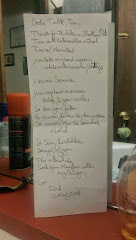
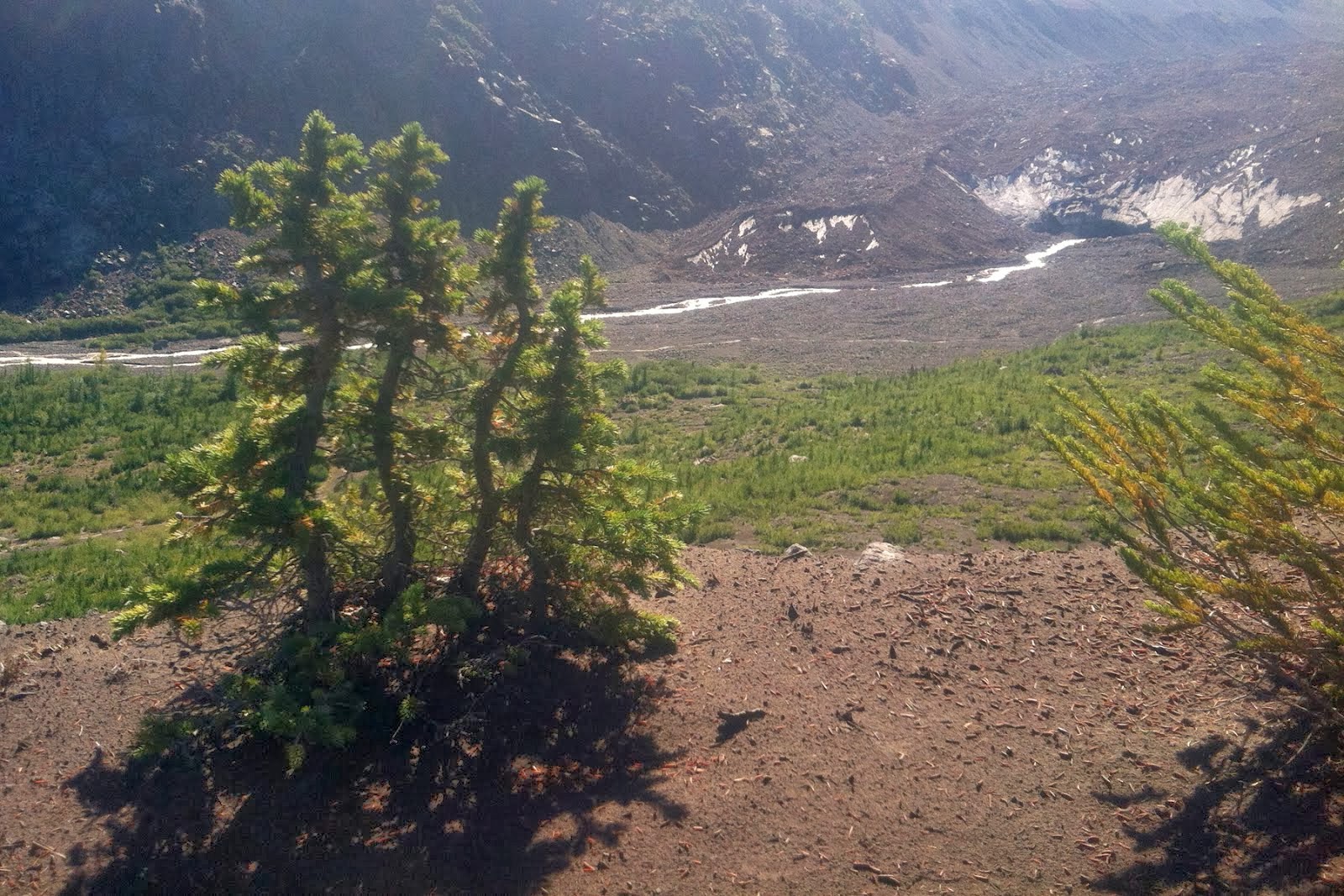
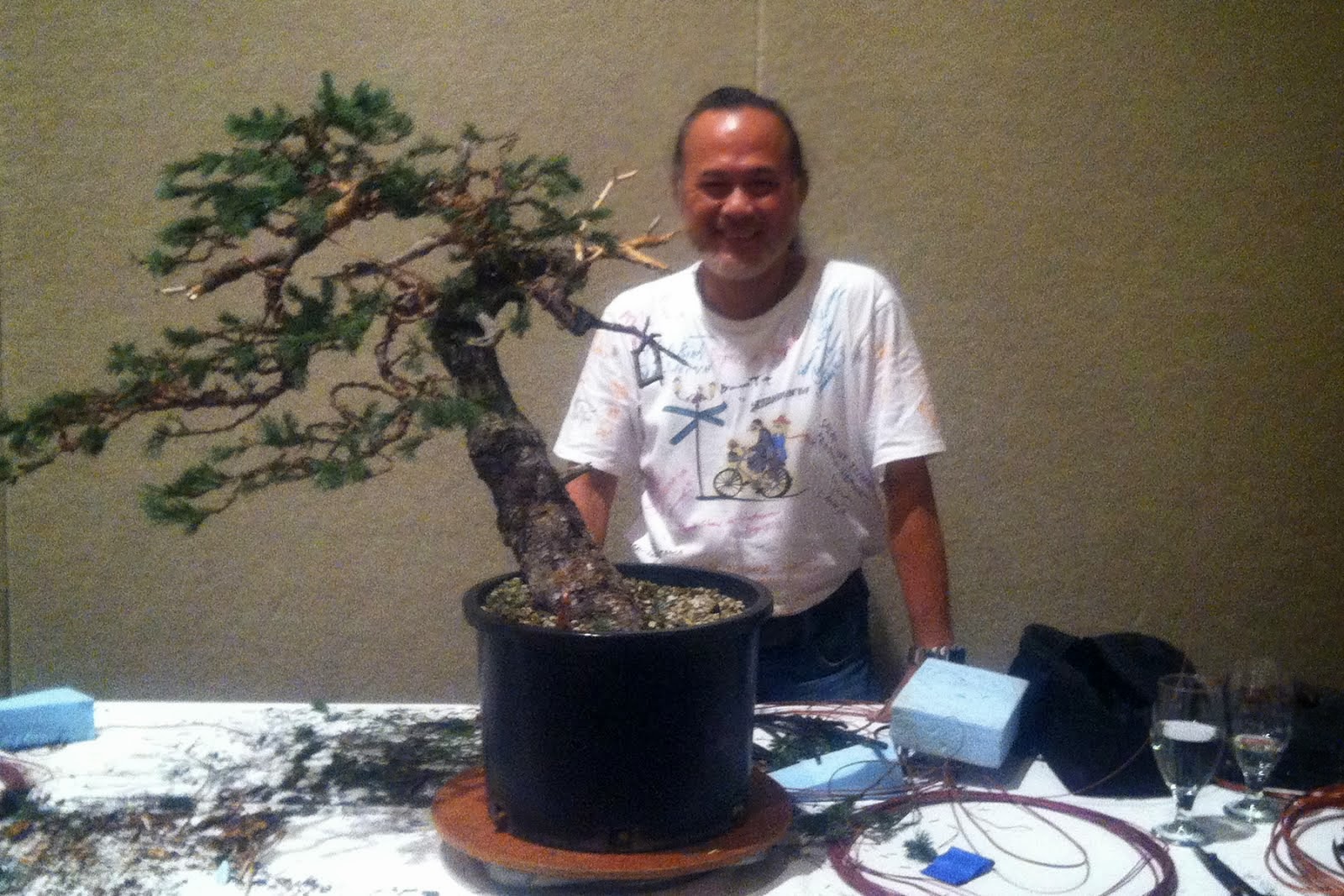

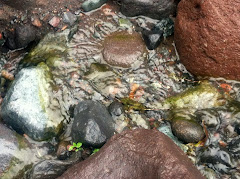

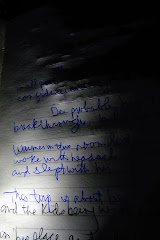

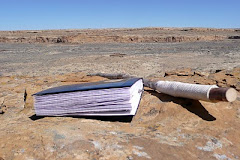
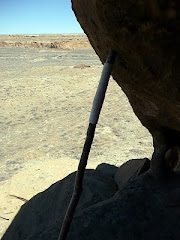

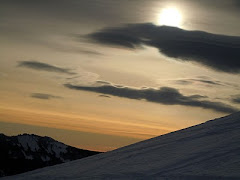
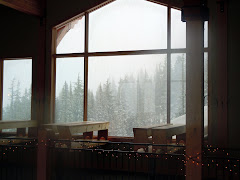


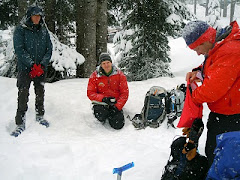
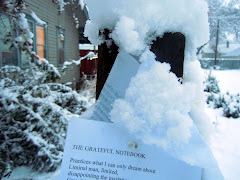

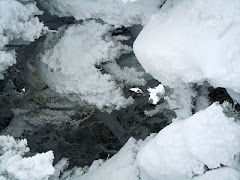
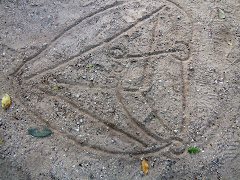
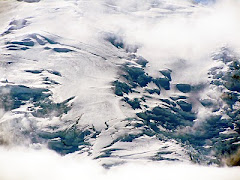
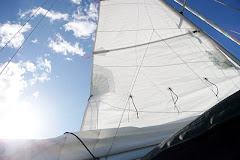
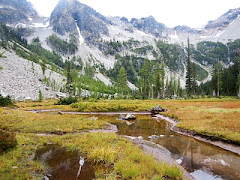


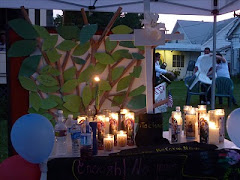
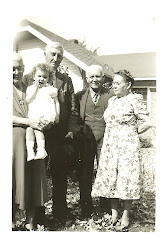




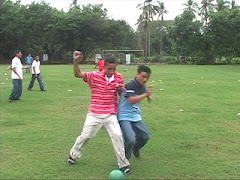
No comments:
Post a Comment